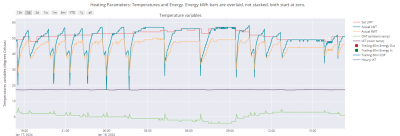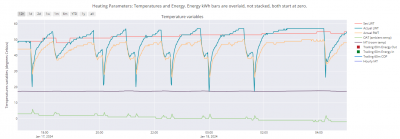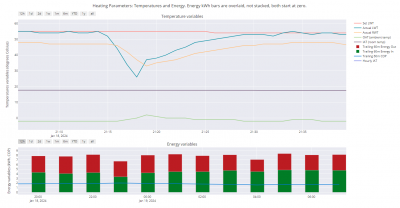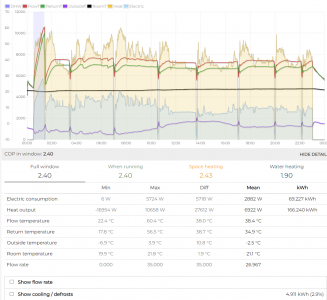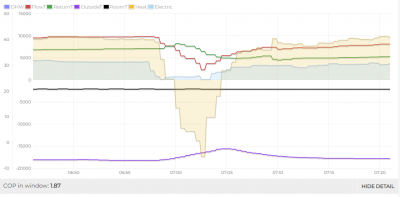@bontwoody very nice to see such a long and steady burn, even at those high flow temps.
Off grid on the isle of purbeck
2.4kW solar, 15kWh Seplos Mason, Outback power systems 3kW inverter/charger, solid fuel heating with air/air for shoulder months, 10 acres of heathland/woods.
My wife’s house: 1946 3 bed end of terrace in Somerset, ASHP with rads + UFH, triple glazed, retrofit IWI in troublesome rooms, small rear extension.
@derek-m Thanks 😊. I’m confident I will be able to reduce the flow temperature once I finish my house renovations and get the COP up.
House-2 bed partial stone bungalow, 5kW Samsung Gen 6 ASHP (Self install)
6.9 kWp of PV
5kWh DC coupled battery
Blog: https://thegreeningofrosecottage.weebly.com/
Heatpump Stats: http://heatpumpmonitor.org/system/view?id=60
Posted by: @hughf@cathoderay quite a lot of short cycling there, have you managed to put your finger on the cause?
They are mostly defrosts, identified by the LWT dipping below the RWT.
In normal running in milder weather, is does cycle, probably because the Midea unit can't lower its output any other way. If you look 12th Jan, OAT just above defrost territory, there were 11 'normal' cycles (the big spike is the DHW), which I have assumed I have to live with, and probably are tolerable, as they aren't that frequent.
Midea 14kW (for now...) ASHP heating both building and DHW
@cathoderay ah yes, because the Midea is only a single fan, for apparently up to 16kW of output... Working that evaporator coil very hard.
My 9kW, with a massive evaporator, seems to defrost only once an hr or so, and it takes moments...
Off grid on the isle of purbeck
2.4kW solar, 15kWh Seplos Mason, Outback power systems 3kW inverter/charger, solid fuel heating with air/air for shoulder months, 10 acres of heathland/woods.
My wife’s house: 1946 3 bed end of terrace in Somerset, ASHP with rads + UFH, triple glazed, retrofit IWI in troublesome rooms, small rear extension.
Posted by: @hughf@cathoderay quite a lot of short cycling there, have you managed to put your finger on the cause?
As CR has stated, those are indeed defrost cycles, though I suspect they are being exacerbated by the two major problems from which his system suffers.
One problem is the PHE which necessitates the heat pump to operate at a LWT that is several degrees above what would be required if the PHE was not present.
The second, and more serious, is the 'cold well effect' from which the system appears to suffer, particularly in colder weather conditions. In basic terms, the colder air being exhausted by the heat pump appears to be being drawn back into the intake. This has a dual effect, the first being that this colder air contains less thermal energy, so the heat pump has to work harder to extract the same quantity of thermal energy. The colder air also lowers the reading being obtain by the OAT sensor, which therefore indicates to the heat pump controller that the OAT is reducing, so it needs to raise the LWT to meet this additional heating demand. Of course the true OAT is not reducing, so the increasing LWT is not balanced by additional heating demand, which means that the LWT continues to increase until it reaches the upper limit and stops the heat pump. The LWT then reduces over a period of about 10 minutes or so, until it reaches the lower limit and the heat pump restarts. The OAT sensor reading also increases by 1C or more during the heat pump 'off' period, thereby preparing the system for the next cycle.
This process can clearly been seen in the 1 minute raw data, an example being:-
The heat pump restarts when LWT falls to say 33C. The heat pump then operates for a period ranging from probably 20 minutes to 60 minutes, dependent upon the OAT and the heating demand, all the time increasing the LWT up to say 45C, at which point the upper limit is reached and the heat pump is stopped.
The heat pump therefore never attains a steady running state where the LWT balances the heating demand. This stopping and starting once or twice each hour, I believe is having a detrimental effect upon the overall efficiency of the system, and causing the whole system to struggle to meet demand during colder weather conditions.
I also believe that the 'cold well effect' is greatly increasing the frequency of defrost cycles, to the point where the heat pump cannot actual meet the heating demand.
Posted by: @hughfJust curious to see if everyone is happy with their comfort and running costs
Not happy with the cost, but I would be worse off with oil, reasonably comfortable right now. I have been trying to track down the cause of the varying COP, seems to be linked to my delta T, something called sub cooling, don't quite understand it yet, still researching. As long as my COP stays above about 3 (rough calculation [edit] 3.47 is my COP to match oil) I should be cheaper than oil ... but for me it will be more about the complete year.
@derek-m - might you be mixing up 'normal' cycles and defrost cycles?
I agree there is a loss over the PHE, meaning the LWT at the heat pump needs to be higher, and that means an efficiency hit. But I am not sure that would trigger more normal cycling, in fact in theory it might reduce it, by raising the demand such that the heat pump didn't need to modulate output by normal cycling. I am not sure how the PHE can influence defrost cycles, except perhaps by causing the pump to work harder, and this causes more defrost cycles.
I agree there is a cooling effect on the OAT near the heat pump, but I think it has less impact than you suggest, eg greatly increasing the frequency of the defrost cycles.
The first thing about the proposed cold well effect is the heat pump isn't in a well, it is actually the highest thing in the vicinity. Ok, we're talking only inches and then feet, but there is no physical well, and apart from the rear, all other sides are surrounded by ground that either immediately or very soon slopes downwards, in some places quite steeply. There is vegetation on two of those three sides, but it is not that close, most is over 1 metre away, and it is not dense. Air can flow through it with ease. It is not in the middle of an open lawn, but nor is it in a well.
More generally, as I understand it, all heat pumps lower the OAT in their vicinity when running, unless they are in a wide open space with a constant breeze blowing blowing them. In other words, almost all heat pumps operate in a 'cold well'. Certainly Midea units and presumably their clones use an OAT sensor in the heat pump, and measure the local OAT rather than the 'true' OAT. How many other heat pump brands also do this? In other words, how exceptional is my heat pump's location, and my Midea heat pump's behaviour? If there is nothing exceptional, then there is no exception effect going on, because there is no exception.
Does my heat pump defrost more frequently (than others)? I'm not sure it does. Let's consider the last 24 hours (this plot comes from the minute data):
The cycles in this plot are mostly defrosts, with two normal cycles around midday today. There are actually five roughly two and a half to three hour long periods with no defrosts; while the total for the 24 period is 12, averaging one every two hours. There are also periods of steady running - no cycles at all. I have noticed this before - the best steady running happens at the sort of OATs I have round here at the moment.
Is this cycling frequency more or less than 'normal'? As so often, we are up against the what is normal question, but it does seem from the plots in the 'Defrost Cycles - How Common Are They?' thread that some heat pumps cycle as frequently, or even more so, while others cycle less.
Lastly, I've just noticed something in the chart above that I haven't noticed before: there appear to be two types of defrost patterns:
Consider the first and last cycles, and then the others in the middle. The former dive straight down, while the latter appear to be triggered by a normal cycle. Could it be that normal cycling can cause defrost cycling?
Midea 14kW (for now...) ASHP heating both building and DHW
One of the problems with correctly analysing the data from your system is that we don't know the true OAT.
I think that most correctly sized and optimised heat pump systems may commence cycling in the 7C to 10C OAT range, and at temperatures below 7C one would expect almost constant operation, until the temperature and humidity start to cause ice build-up and the need for cycling.
The term 'cold well' does not mean the heat pump is in a hollow, merely that there is restriction to the free flow of air around the pump, or that the exhaust air is somehow being deflected back towards the intake. The first time I suspected that your heat pump may be suffering from a 'cold well' effect, was when I analysed some of the minute raw data that you supplied I think back in November, when a setback started the OAT reading increased by I think 4C or 5C in a relatively short space of time. If you look at the raw data for 17th December 2023, when the setback commenced at 20:56 the OAT reading was 10C, but by 21:13 this had increased by a full 3C to 13C, which I doubt would be deemed as normal ambient air temperature variation.
You are correct that charts posted by other members do show variations in OAT readings, but without detailed data such as that you have supplied it is difficult to be certain about the true cause.
Along with measuring the true OAT and comparing readings, you could try making a temporary baffle between the front and rear of the heat pump. Cardboard boxes or plastic sheeting arranged to try to prevent air from the front area being drawn into the rear area.
You could try the 'Newbie' smoke bomb approach to see how the air around the heat pump appears to be flowing.
I may be totally wrong, but the evidence so far would seem to indicate that my assessment may be correct.
@william1066 it’s a hard one to compete against, Oil…. Definitely the cheapest fuel source for home heating.
I went into this with a break even with gas COP target of 2.86. I think we’ll get that over the year.
Doubt we will be at this time of year but it’s not costing me more than £100/week for all our electricity, so I can’t complain.
Off grid on the isle of purbeck
2.4kW solar, 15kWh Seplos Mason, Outback power systems 3kW inverter/charger, solid fuel heating with air/air for shoulder months, 10 acres of heathland/woods.
My wife’s house: 1946 3 bed end of terrace in Somerset, ASHP with rads + UFH, triple glazed, retrofit IWI in troublesome rooms, small rear extension.
@derek-m it’s interesting you discuss the changes in outside air temp as registered by the sensor, so commonly mounted on the evaporator guard.
Mine spikes at 25 degrees just after a defrost. It’s a good job I don’t have automatic switchover to cooling enabled or it would get itself into a changeover loop…
Mine is in the middle of the garden, 500mm away from the fence panel. No issues with microclimates here.
Off grid on the isle of purbeck
2.4kW solar, 15kWh Seplos Mason, Outback power systems 3kW inverter/charger, solid fuel heating with air/air for shoulder months, 10 acres of heathland/woods.
My wife’s house: 1946 3 bed end of terrace in Somerset, ASHP with rads + UFH, triple glazed, retrofit IWI in troublesome rooms, small rear extension.
@derek-m - thanks. I'll see what I can come up with in the way of smoke bombs (what could possibly go wrong? Last autumn an awkward neighbour read me the Bonfire Act - I had to point out there isn't one), though I think once one gets going it might be difficult to see the actual flow. Some sort of lesser smoke feed/generator placed behind the heat pump and operated intermittently might be easier to interpret. Temporary baffles shouldn't be that difficult to set up, I do have some DPM +/- hardboard I could use, and the baffle won't need to be that high, maybe level with the top of the heat pump casing, as the air we are concerned about is cold than the air it is cooling and so will tend towards low level. Not a project for today though, it is currently -4 degrees C outside! 60m trailing COP is 1.69 and has been thereabouts all night, energy in is around 4.75 kWh per hour, that's over 100 kWh per day at that rate. There were 13 defrosts in the 12 hour overnight period. House is currently 2 degrees C below design temp.
Once the baffles are in place, I think we need to look at the OAT spikes. If the recirculating air is a problem, and the baffles reduce or stop the recirculation, then the spikes should be less obvious, perhaps even disappear.
I have also ordered modbus enabled IP67 OAT sensor but it won't arrive for a while as it comes from China. I will need to decide where to put it, preferably without drilling holes in walls. Dangling in free air from the north facing eaves, with the modbus cable running up from the airing cupboard into the attic and then to the eaves, might be a possibility. Any other ideas/suggestions very welcome.
@hughf and @derek-m - I think microclimate is a much more useful term than cold well.
FWIW, here is the detail on a typical defrost cycle, this one from 9.15 yesterday evening:
Midea 14kW (for now...) ASHP heating both building and DHW
@hughf here's my (worse than) design conditions day, yesterday, 18th jan, -7C at 0600. HP usage was 69kwh electricity generating 166kwh of heat.
Run costs are substantially reduced as I fully charge my batteries on Intelligent Octopus and have PV. On a very cold but also very sunny day such as yesterday, I used approx 10kwh at 30p (£3), 50kwh at 7p (£2.80) , 20kwh free from the sky. Total £5.80. Of that, 69kwh went into the heating, 21kwh ran everything else in the house. Cars didn't charge yesterday if they had that would have raised the cheap rate quantity a lot.
Internal comfort warmth levels are just as good as in milder weather , a steady 21 to 22C. LWT at these temps (40C) and property heat loss (~9kw) is better than I had planned for. COP is comparing well with the Samsung EHS databook figures. Happy with my own work 😀
Defrosts are done and system back to within 2C of target LWT in 10 mins
My octopus signup link https://share.octopus.energy/ebony-deer-230
210m2 house, Samsung 16kw Gen6 ASHP Self installed: Single circulation loop , PWM modulating pump.
My public ASHP stats: https://heatpumpmonitor.org/system/view?id=45
11.9kWp of PV
41kWh of Battery storage (3x Powerwall 2)
2x BEVs
- 26 Forums
- 2,417 Topics
- 54.8 K Posts
- 256 Online
- 6,096 Members
Join Us!
Worth Watching
Latest Posts
-
RE: Octopus Cosy 12 Heat Pump Regret: Incredibly Loud, Poor Heating & Constant Hum - Help!
So, after much anguish, and even visiting the neighbour...
By razz , 3 hours ago
-
MLCP (Multi-Layer Composite Pipe) for ASHP
@editor nope. The info you reported was sufficient for ...
By iotum , 5 hours ago
-
RE: Advice for a novice on Mitsubishi Ecodan 6kW
@robs Quick response while I'm in stationary traffic le...
By Sheriff Fatman , 5 hours ago
-
RE: Setback savings - fact or fiction?
Maths looks right to me, my only question about this ca...
By JamesPa , 5 hours ago
-
RE: Ideal HP290 14kW ASHP - how to optimise
@jamespa I wasn’t offended at all. You are very knowled...
By Davesoa , 6 hours ago
-
RE: Experience - New Build / Complete New Heating System
@vincro I would be surprised if it is much above 5 to 6...
By ASHP-BOBBA , 6 hours ago
-
RE: Recommended home battery inverters + regulatory matters - help requested
Yes, certainly not enough could have been tested in any...
By Batpred , 7 hours ago
-
RE: Post-Traumatic Heat Pump Stress Disorder
Yes bang on and maybe I can illustrate that by way of e...
By iotum , 8 hours ago
-
-

RE: Replacing my 18 month old Hitachi Yutaki ASHP
A big thank you to @jamespa for all his efforts online ...
By trebor12345 , 11 hours ago
-

RE: GSHP WOES! Midland based engineer recommendations?
@editor It is indeed for servicing. My current service ...
By Morgan , 12 hours ago
-
RE: Sunsynk Whole House Backup Issue
Hi @lostandconfused , I agree that topic/thread is the ...
By Batpred , 12 hours ago
-
RE: Speedcomfort radiator fans
In case it helps Andrew Kuhne on openenergy monitor has...
By JamesPa , 13 hours ago
-

Things have gone quiet with you @drei. Any updates?
By Mars , 16 hours ago
-

RE: Passiv Smart Thermostat - Help & Forum Support
Thanks @tim441. Interesting timing, as Passiv are a cur...
By Mars , 18 hours ago
-
Hi everyone, I have a two year old Marlec Solar iBoos...
By Tallmarc , 20 hours ago
-
RE: Please help with the settings ecodan
Are you trying to address any particular performance is...
By Sheriff Fatman , 1 day ago
-
RE: Solis inverters S6-EH1P: pros and cons and battery options
🤣 Well, I never managed to get the HA solis "...
By Batpred , 1 day ago



